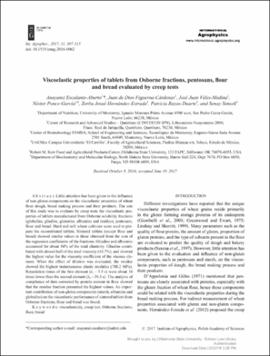| dc.contributor.author | Escalante-Aburto, Anayansi | |
| dc.contributor.author | Dios Figueroa-Cardenas, Juan de | |
| dc.contributor.author | Veles-Medina, Jose Juan | |
| dc.contributor.author | Ponce-Garcia, Nestor | |
| dc.contributor.author | Hernandez-Estrada, Zorba Josue | |
| dc.contributor.author | Rayas-Duarte, Patricia | |
| dc.contributor.author | Simsek, Senay | |
| dc.date.accessioned | 2019-09-25T18:24:49Z | |
| dc.date.available | 2019-09-25T18:24:49Z | |
| dc.date.issued | 2017 | |
| dc.identifier | oksd_escalanteaburto_viscoelasticpr_2017-01-01 | |
| dc.identifier.citation | Escalante-Aburto, A., Dios Figueroa-Cardenas, J. d., Veles-Medina, J. J., Ponce-Garcia, N., Hernandez-Estrada, Z. J., Rayas-Duarte, P., & Simsek, S. (2017). Viscoelastic properties of tablets from Osborne fractions, pentosans, flour and bread evaluated by creep tests. International Agrophysics, 31(3). https://doi.org/10.1515/intag-2016-0062 | |
| dc.identifier.uri | https://hdl.handle.net/11244/321457 | |
| dc.description.abstract | Little attention has been given to the influence of non-gluten components on the viscoelastic properties of wheat flour dough, bread making process and their products. The aim of this study was to evaluate by creep tests the viscoelastic properties of tablets manufactured from Osborne solubility fractions (globulins, gliadins, glutenins, albumins and residue), pentosans, flour and bread. Hard and soft wheat cultivars were used to prepare the reconstituted tablets. Sintered tablets (except flour and bread) showed similar values to those obtained from the sum of the regression coefficients of the fractions. Gliadins and albumins accounted for about 54% of the total elasticity. Gliadins contributed with almost half of the total viscosity (45.7%), and showed the highest value for the viscosity coefficient of the viscous element. When the effect of dilution was evaluated, the residue showed the highest instantaneous elastic modulus (788.2 MPa). Retardation times of the first element (λ1 ̴ 3.5 s) were about 10 times lower than the second element (λ2 ̴ 39.3 s). The analysis of compliance of data corrected by protein content in flour showed that the residue fraction presented the highest values. An important contribution of non-gluten components (starch, albumins and globulins) on the viscoelastic performance of sintered tablets from Osborne fractions, flour and bread was found. | |
| dc.format | application/pdf | |
| dc.language | en_US | |
| dc.publisher | De Gruyter Open | |
| dc.rights | This material has been previously published. In the Oklahoma State University Library's institutional repository this version is made available through the open access principles and the terms of agreement/consent between the author(s) and the publisher. The permission policy on the use, reproduction or distribution of the material falls under fair use for educational, scholarship, and research purposes. Contact Digital Resources and Discovery Services at lib-dls@okstate.edu or 405-744-9161 for further information. | |
| dc.title | Viscoelastic properties of tablets from Osborne fractions, pentosans, flour and bread evaluated by creep tests | |
| osu.filename | oksd_escalanteaburto_viscoelasticpr_2017-01-01.pdf | |
| dc.description.peerreview | Peer reviewed | |
| dc.identifier.doi | 10.1515/intag-2016-0062 | |
| dc.description.department | Robert M. Kerr Food and Agricultural Products Center | |
| dc.type.genre | Article | |
| dc.type.material | Text | |
| dc.subject.keywords | viscoelasticity | |
| dc.subject.keywords | creep test | |
| dc.subject.keywords | osborne fractions | |
| dc.subject.keywords | fluor | |
| dc.subject.keywords | bread | |
